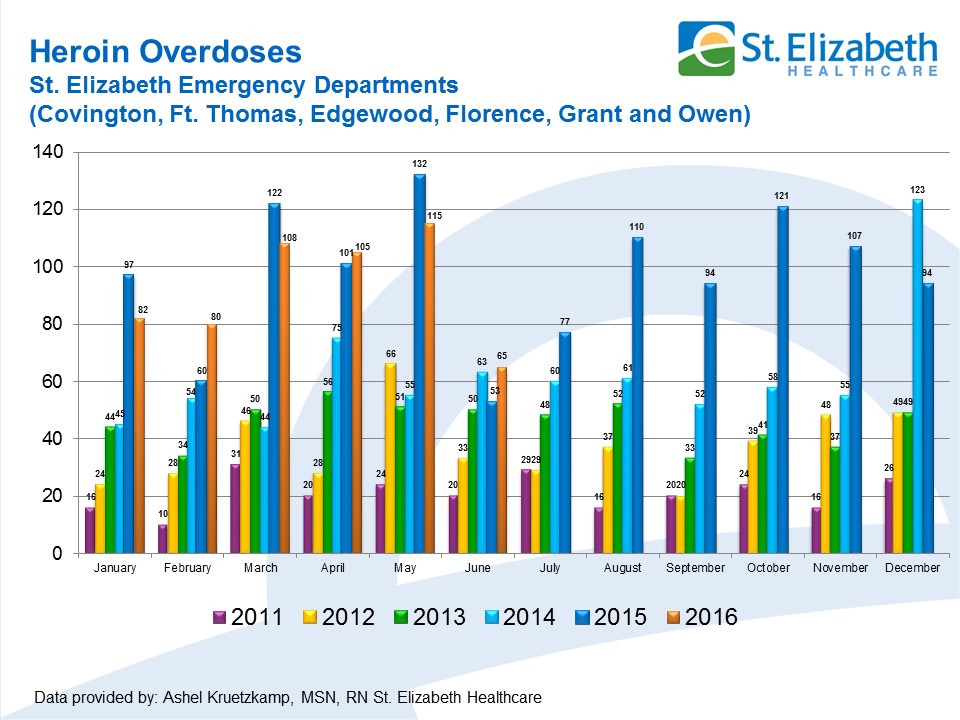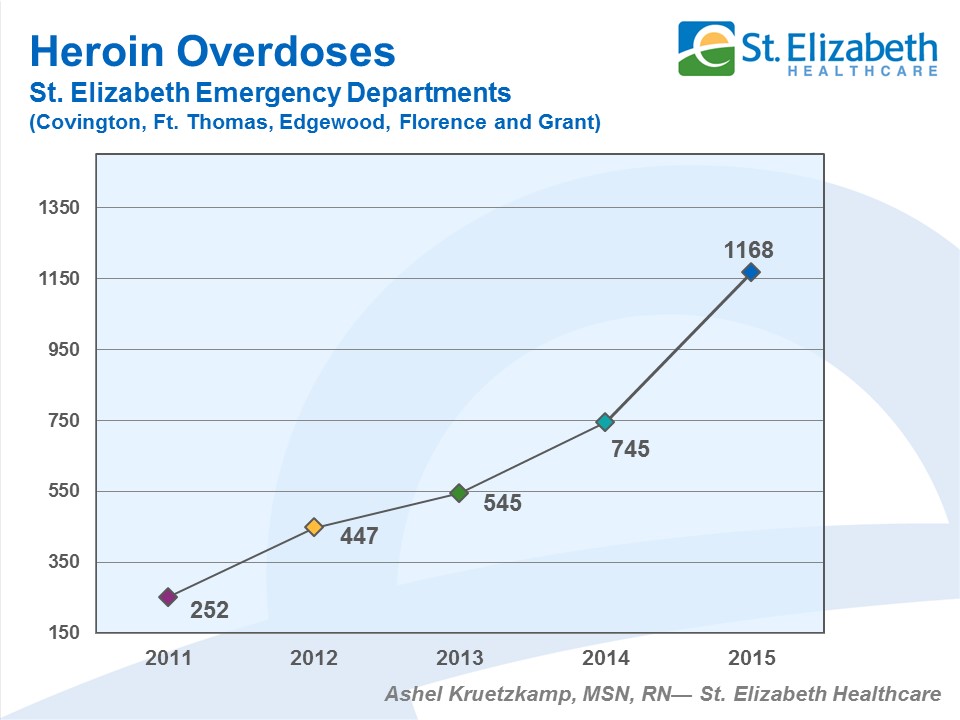By Mark Hansel
NKyTribune managing editor
The heroin overdose wave that pushed first responders to the limit in Cincinnati last week was felt strongly on the Kentucky side of the river as well.
More people were treated for heroin overdoses at St. Elizabeth Healthcare emergency rooms last week than in the entire month of June.

Heroin overdoses at St. Elizabeth Emergency Departments from January, 2011 through June, 2016, courtesy of St. Elizabeth Healthcare (click to enlarge).
St. Elizabeth Healthcare reports that its six emergency departments treated 75 cases of heroin overdoses in the week that ended Sunday (Aug. 28).
In all of June this year, the last month for which complete statistics are available, St. Elizabeth treated just 65 cases. Since January 2011, the most overdoses St. Elizabeth emergency rooms have treated in any one month is 132, in May of last year.
Sadly, that dubious record could be in jeopardy, as a more potent form of the drug has hit the streets.
“We are definitely sharing some of Cincinnati’s increase in overdose numbers in our emergency departments in Northern Kentucky as well,” Ashel Kruetzkamp, nurse manager for St. Elizabeth Healthcare, said. “The Ohio River is not that big of a border; people go into Ohio to buy their drugs and people from there come into Northern Kentucky to buy drugs. Usually we follow suit pretty well and if there is a ‘bad batch’ or stronger potency, I use the term that there is a new dealer in town.”
Those new dealers are increasingly adding powerful, and potentially lethal, ingredients such as fentanyl and carfentanil to heroin to increase its potency. Fentanyl can be up to 100 times more potent than morphine and 50 times more powerful than pure heroin. Carfentanil, used as an elephant tranquilizer, is 100 times more powerful than fentanyl.
Kruetzkamp says the potency of these new mixtures can make Narcan (naloxone), a drug used to revive overdose victims, less effective.

Heroin overdoses in St. Elizabeth Emergency Departments, by year, beginning in 2011, through 2015, courtesy of St. Elizabeth Healthcare (click to enlarge).
“We are seeing it take a lot more Narcan to bring a patient back from an overdose,” Kruetzkamp said. “In the past, we might have been able to use 2 mg. or less, but now it’s taking a lot more. One gentleman needed 10 mg. of Narcan and just Monday night it took 6 mg. to bring a patient back and he was very drowsy and not breathing on his own.”
The number of cases treated at St. Elizabeth’s emergency rooms do not include those who may have been revived at home or other instances where overdoses were not treated at one of the group’s hospitals.
The heroin epidemic has allowed Narcan to be more readily available to addicts, first responders and family members of those who use heroin regularly.
“The fear is, that with the potency of the drug that’s in our community, you’re playing Russian roulette,” Kruetzkamp said. “You truly are.”
Prescription opioids are also dangerous, but there is some consistency because each dose uses a regulated chemical formula. That has never been the case with heroin and it is even less so now.
“This isn’t science and they are cutting it with just about everything to intensify the high,” Kruetzkamp said. “A gentleman that overdosed the other day said he used the same amount, but that doesn’t matter because the potency could be completely different from the last time they got it. You try to explain that, but when they are in withdrawal, they are going to take whatever they can get and they don’t consider that a risk.”
Heroin has proved a stubborn and resilient foe in the region’s opioid war, but there have been signs of progress recently thanks to education, the increased distribution of Narcan and more widespread treatment.
This recent spike in overdoses, however, has some questioning just how much progress has truly been made.
Kruetzkamp says the goal is to keep overdose victims alive, so they can potentially get free from addiction and last week’s numbers show progress has been made on that front.
 “Law enforcement has Narcan and family members who have loved ones that are addicted have Narcan kits now,” she said. “If this had happened two years ago, there would have been a lot more lives lost. We can’t put dead people in treatment.”
“Law enforcement has Narcan and family members who have loved ones that are addicted have Narcan kits now,” she said. “If this had happened two years ago, there would have been a lot more lives lost. We can’t put dead people in treatment.”
The administering of Narcan outside of a hospital setting, Kruetzkamp said, should be followed up with treatment from emergency medical personnel.
“The fear that I have is that most of the Narcan that’s in the homes or that law enforcement has is either two or four milligrams and it’s taking more than that sometimes to bring an individual out of the overdose,” Kruetzkamp said. “People still need to be calling 9-1-1 and getting them to next-level care. When you are talking about carfentanil, that’s a lot longer lasting, so you could be out a lot longer or need a repeat dose.”
Thanks to the efforts of law enforcement and emergency medical personnel, this recent rash of overdoses was not nearly as deadly as it might have been.
There’s no telling, however, when the next “bad batch” of potentially deadly heroin will invade the region, and those who pump it into their veins might not be so lucky.
Contact Mark Hansel at mark.hansel@nkytrib.com
















